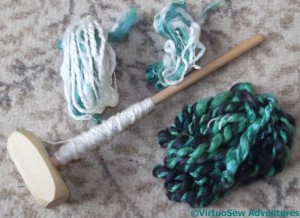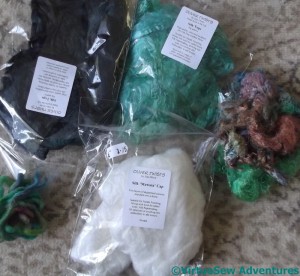Spinning
I don’t usually go to workshops at the Knitting and Stitching Show, but since I’ve taken to going to the Thursday evening opening as well, I thought I would have time this year.
And I did. I went to a workshop on Spinning Silk Mawata with Ruth MacGregor, and came back with my very own drop spindle to play with.
First of all I’ve never been to any fibre related workshop at which there were tubes of handcream on the table! Secondly, although I have – literally! – written a book about spinning, I’ve never held a drop spindle in my life and I had no idea what to expect. My book is about industrial spinning, and the machines always did the difficult stuff…
It turns out that silk mawata is a web of filament that can be drafted (stretched) and spun fairly easily – it’s a forgiving material, and because silk is so strong and the filaments are so long, it’s easy to draft and create fine threads. Of course, that means that spinning heavier threads is going to take a bit more thought and care.
Or – since Ruth taught us how – there is always the possibility of twisting two threads together to make one. In the photo above you can see my early efforts. The two light ones are both fairly simple plied yarns, but speaking as a fancy yarn specialist, the dark one is a slubbed gimp yarn. I just wish I could claim that that was exactly as I designed it to be!
So I came home with a packet of silk mawata caps and some silk tops, so I can play and learn to make the thread I want to make.
Eventually I want to be able to spin in both wool and silk, and use some of my yarns in the Vision of Placidus panel…



Well, that IS impressively back to basics! Can you weave too?
I guess that if you *really* want to go back to basics: http://www.wormspit.com/mawatas.htm
I have to admit that I bought a drop spindle a couple of years ago at Woolfest …… and have never used it! Maybe I should follow your example and find a workshop to go to.
That sounds like fun. That’s not exactly the stick the Navajo women use, but I used to be fascinated watching them use theirs. Your yarns look wonderful, and I especially like the greens. Such pretty threads!
I bought a book about using a drop spindle and looked at a bunch on line…but never bought a spindle! I still think it seems like an enjoyable activity with pride of product at the end!
What about the hand lotion? When do you use that? I’ve always thought of hand lotion as a no-no around yarn and fibers.
Wow _ is there no end to what you can do? 😉 Enjoy!
Have fun! The drop spindle is in my wish list …I’m learning to use a spinning wheel in weaving class .. Silk must be a bit difficult than wool fibre to handle but am impressed with your results 🙂
Fantastic! I leant to spin on a drop spindle a few years ago but never took it up as i’m not a knitter. I hadn’t thought of spinning threads to embroider with!
When I see the drop spindle and the yarn I thought of making the the yarn for nuno felt that the textures are great. Enjoy it.
I am certain it won’t be long until you are creating wonderous things with this Rachel. Have a wonderful Christmas!!
Wow! I’m certainly impressed! Those are lovely yarns you spun. I may have to try this. I live in Northern Colorado now, home of Interweave, and there is a lot of spinning/weaving activity here.
Yaaay! A fellow spinning embroiderer. You can do this! I found the learning curve for spinning was a bit steep, but I kept at it. I figured that once upon a time every 10 year old could spin a fine thread – so why not me! Just don’t expect your skeins to come out looking like they came off the DMC rack at your LYS…but if you persevere you just might find you can produce some really interesting textures that money can’t buy! I found wool is much easier to learn technique with than than the matawa…Good luck! SpinOff Magazine is a great resource for a newbie! Another rule of thumb is that the weight of your spindle ‘controls’ the weight of the yarn…light spindle – fine yarn…chunky spindle = chunky yarn.
Oh, the years and years spent demonstrating to kids how a drop spindel works and then the tangles. Such memories. I remember we used to add more platercine on the base to work with that chunky yarn that was easier to manage. I have seen the ladies in Peru work with their drop spindles, just magic. Have fun.
That looks like great fun – I’ve recently become intrigued with both spinning and weaving – not enough yet for a wheel or loom, but perhaps fiddling in a small scale… a drop spindle looks like it might be the perfect thing. It’s such a pleasure to come here and see what you’re working and/or experimenting on.